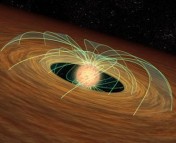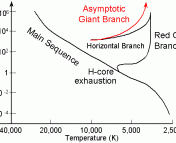Title: Searching for magnetic fields in pulsating A-type stars: the discovery of a strong field in the probable δ Sct star HD 340577 and a null result for the γ Dor star HR 8799
Authors: S Hubrig, S P Järvinen, J D Alvarado-Gómez, I Ilyin, M Schöller
First Author’s Institution: Leibniz-Institut für Astrophysik Potsdam (AIP), An der Sternwarte 16, 14482 Potsdam, Germany
Status: Published in Monthly Notices of the Royal Astronomical Society: Letters [closed access]
Background
For stars cooler than about 7000 Kelvin (K), we regularly observe magnetic fields. For hotter stars, though, hosting a substantial magnetic field is much rarer. This is because unlike the Sun, which has a convective outer envelope, these hot stars have a radiative envelope. When a region is radiative rather than convective, the energy transport is driven by the luminosity of the region rather than the motion of packages of gas. Without the collective motion of charged particles that convection provides, magnetic fields cannot be maintained through dynamo action.
However, about 15% of stars with a temperature between about 7,000K to 20,000K host magnetic fields between a few tens of Gauss (G) to a few tens of thousands of Gauss– much stronger than the Sun’s 1G average magnetic field! These fields are likely dependent on the stars being chemically peculiar, usually meaning that they have over-abundances of certain elements. As it turns out, having such a strong magnetic field not only depends on the internal structure of the star, but impacts the internal structure as well.
The field of astroseismology investigates the structure of stars by looking for the specific ways they oscillate and respond to perturbations, like the restoring force of a spring. These oscillations produce pulsations, or periodic changes in the luminosity of the star, that we can measure. There are two major restoring forces at work in stars: 1.) pressure, which is dominant in the convective zone and produces p-mode oscillations and 2.) gravity, which is dominant in the radiative zone, producing g-mode oscillations which are generally lower frequency than p-modes. When magnetic fields are added to the mix, things get more complicated. If the field is strong enough, certain modes can be suppressed, or ‘damped’ – modes you might normally expect to see are snuffed out.
The Paper
This principle is the inspiration for the work presented in this paper. The authors investigate the effect of this “magnetic damping” for two types of hot, oscillating stars. One of these stars is what’s known as a delta Scuti variable– these are main sequence stars (i.e. stars that are still burning hydrogen in their core) that experience brightness changes at a periodicity that depends on its luminosity, similar to the more popular Cepheid variable. They have pulsation periods on the order of a few minutes to a few hours. The other type of star they consider is another main sequence star called a gamma Doradus variable. These stars don’t have the same period-luminosity relation that the delta Scuti variables do, and their pulsation period is much longer (or equivalently, their frequency is lower, perhaps suggesting g-mode dominance)– between 8 hours to as long as a few days. The question is: what are the magnetic fields for these variable stars like?
To answer this, the authors used the Potsdam Echelle Polarimetric and Spectroscopic Instrument (PEPSI). This instrument has two spectrometers that allow it to measure both the linear and circular polarization of the incoming light. This is crucial for studying stellar magnetic fields since magnetic fields will polarize light in a circular fashion– the degree of circular polarization measured by PEPSI gives information about the star’s magnetic field strength.
The authors used PEPSI to look at a chemically peculiar star that was recently identified as a delta Scuti variable named HD 340577 (HD34) and a gamma Doradus variable called HR 8799 (HR87), as shown in Figure 1. The spectral type of these two stars is about all they have in common; HR87’s 0.9-day rotation period is much shorter than HD34’s 116-day period, HR87 experiences pulsations with a 0.5-day period compared to HD34’s 0.06-day pulsation period, and, as these authors show, HR87 has no detectable magnetic field while HD34 has a field that may be as strong as 1,200G.

Although 1,200G isn’t so unusual for other chemically peculiar stars, it is the strongest magnetic field ever found on a delta Scuti variable. Interestingly, the other delta Scuti variables that have strong magnetic fields are also slow rotators, perhaps suggesting that astronomers would be more likely to detect a magnetic field on a delta Scuti variable if they target those with long rotation periods. It’s also worth noting that the strength of HD34’s (the gamma Doradus variable) oscillation modes, as well as the typical oscillation-mode strength of other delta Scuti variables with strong fields, are weak– around an order of magnitude weaker than HR87’s oscillations. This may be consistent with the idea that strong magnetic fields dampen the oscillation modes. However, the origin of gamma Dor variability is not well understood, and the nature of their magnetic fields even less so. It may be that strong magnetic fields completely extinguish low-frequency oscillations, and so being a gamma Dor variable and having a strong magnetic field may be completely mutually exclusive!
This work represents the start of a systematic study of magnetic fields for delta Scuti and gamma Dor variables and what these fields mean observationally, rather than theoretically, for the pulsation modes observed in such stars. As this study continues, it will be exciting to more robustly learn under which conditions these fields are present, and what that might mean for their production.
Astrobite edited by Aldo Panfichi
Featured image credit: adapted from Sylvain Cnudde of LESIA/Observatoire de Paris and Figure 2 of Mathys G., Kurtz D.W. and Holdsworth D.L, 2022




